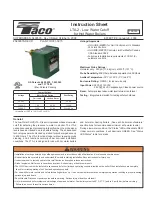
SETUP & OPERATION
HeatNet Control V3
Page 13
5.
With the blower started, the ignition control waits for
the air switch to close. When the air switch closes it
provides an input to the PSW terminal of the ignition
control module and pre-purge timing commences. The
H-Net display indicates “Pre-Purge”.
6.
When pre-purge is complete the ignition control
energizes the gas valve from terminal V1, and the spark
is generated from terminal HV Out, beginning a 4-
second trial for ignition.
7.
At the end of the trial for ignition the spark is de-
energized. If the flame is detected, by the flame rod, the
H-Net display indicates “Running XX%”
8.
If main-flame is detected the H-Net control holds the
burner at the low-fire rate for the MODULATION
DELAY time period. After this timer expires, the PID
allows the boiler to modulate and places the boiler into
the running state.
As boilers are added to the system settings in the
SETTINGS: ADAPTIVE MODULATION MOD: DROP DOWN
menu determines when the modulation rate drops down to
compensate for the newly added BTUs. For the drop down
to be active, one boiler needs to be running when a new
boiler is added (see:
Introduction: The
Torus
SERIES H-Net
Control: Master
).
If all boilers are firing, the modulation rate is released to go
to 100%. If all boilers are not firing, the modulation is
limited to the MOD-MAX clamp value. The MOD-MAX
clamp keeps the boilers running as efficiently as possible.
The following
Mixed Boiler System Operation: Selecting
Mixed Boilers
section outlines this with examples.
NOTE:
If the boiler is running as a stand-alone boiler or
is direct modulated (including the AA input),
the MOD-MAX clamp will also be in effect for
the ADD BOILER DELAY time. This is to
minimize thermal shock to the boiler.
Once the header water temperature is in the heating band,
only the modulation rate is used to achieve the target
setpoint. The system will maintain the setpoint until the load
demand increases or decreases.
As the load decreases, the header water temperature will
start approaching the top of the band. The PID now lowers
the modulation rate to the boilers, attempting to keep the
temperature within the heating band. If the system is
delivering too many BTUs, the water temperature will cross
the top of the heating band.
When the header water temperature first exceeds the top of
the heating band, the boilers are again checked for the one
with the most runtime. The selected boiler will turn off
immediately and a shed boiler delay timer will be loaded
with the delay time. This time will need to expire before the
next boiler is stopped, but only if the header water
temperature remains above the heating band. This timer is
used to allow the header water temperature to return back
into the band when a boiler is stopped. When a boiler is
stopped there is a fixed rate of BTUs (Min Fire) that will be
removed (PID discontinuity to modulate from Min Fire to 0
BTUs on a boiler). The timer allows for this loss of BTUs.
This cycle will continue until the call for heat is satisfied or
the Warm Weather Shutdown feature is enabled.
Mixed Boiler Types Using
Priority Sets
Using the
Basic Multi Boiler System Operation
, a MIXED
boiler Priority method may be added to control condensing,
non-condensing, base load, or other boiler
SETs
in a system
together. These sets compose a system which provides for
optimal performance and economy. Having dedicated sets
of boilers gives the system engineer a tool to create many
different boiler systems.
A boiler set can be constructed by simply setting the firing
Priority on each boiler (to be in a set) at the same priority.
Setting all (example) condensing boilers to the highest
Priority of 1, and then setting all (example) non-condensing
boilers to a Priority of 2, will create (2) sets of boilers, one
condensing and the other non-condensing. Once this is
done, the Priority 1 set of condensing boilers will have a
firing order that has a higher Priority and is independent of
the other non-condensing set with the lower priority. The
boiler set with the highest Priority can then be fired based
on a conditional settings menu. The lower Priority set will
follow.
Mixed Boiler System Operation
Starting Boilers:
When a boiler is to be fired (water temp is below the heating
band), the Master checks the HeatNet boilers it has
available. The Master boiler then looks at which boilers are
returning Priority firing status (set on a boiler in:
(SETTINGS: FIRING MODE: FIRING PRIORITY:
PRIORITY:
1
). If the Start condition for the Priority 1 set is
met (SETTINGS: FIRING MODE: MIXED BOILERS
FIRST
(
example
), the Master or Member boiler that is
configured as PRIORITY 1, with the lowest runtime, will be
fired
FIRST
(
example
).














































